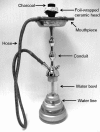Waterpipe tobacco smoking: what is the evidence that it supports nicotine/tobacco dependence?
- PMID: 25492935
- PMCID: PMC4345797
- DOI: 10.1136/tobaccocontrol-2014-051910
Waterpipe tobacco smoking: what is the evidence that it supports nicotine/tobacco dependence?
Abstract
Objective: Waterpipe tobacco smoking (WTS) involves passing tobacco smoke through water prior to inhalation, and has spread worldwide. This spread becomes a public health concern if it is associated with tobacco-caused disease and if WTS supports tobacco/nicotine dependence. A growing literature demonstrates that WTS is associated with disability, disease and death. This narrative review examines if WTS supports nicotine/tobacco dependence, and is intended to help guide tobacco control efforts worldwide.
Data sources: PUBMED search using: (("waterpipe" or "narghile" or "arghile" or "shisha" or "goza" or "narkeela" or "hookah" or "hubble bubble")) AND ("dependence" or "addiction").
Study selection: Excluded were articles not in English, without original data, and that were not topic-related. Thirty-two articles were included with others identified by inspecting reference lists and other sources.
Data synthesis: WTS and the delivery of the dependence-producing drug nicotine were examined, and then the extent to which the articles addressed WTS-induced nicotine/dependence explicitly, as well as implicitly with reference to criteria for dependence outlined by the WHO.
Conclusions: WTS supports nicotine/tobacco dependence because it is associated with nicotine delivery, and because some smokers experience withdrawal when they abstain from waterpipe, alter their behaviour in order to access a waterpipe and have difficulty quitting, even when motivated to do so. There is a strong need to support research investigating measurement of WTS-induced tobacco dependence, to inform the public of the risks of WTS, which include dependence, disability, disease and death, and to include WTS in the same public health policies that address tobacco cigarettes.
Keywords: Addiction; Global health; Nicotine.
Published by the BMJ Publishing Group Limited. For permission to use (where not already granted under a licence) please go to http://group.bmj.com/group/rights-licensing/permissions.
Figures
References
-
- World Health Organization. World Health Organization Report on the Global Tobacco Epidemic, 2011: Warning about the dangers of tobacco. Geneva, 2011.
-
- US Department of Health and Human Services. The Health Consequences of Smoking: 50 Years of Progress. A Report of the Surgeon General. Atlanta, GA: US Department of Health and Human Services, Centers for Disease Control and Prevention, National Center for Chronic Disease Prevention and Health Promotion, Office on Smoking and Health, 2014.
-
- Centers for Disease Control and Prevention. Smoking-attributable mortality, years of potential life lost, and productivity losses—United States, 2000–2004. Morb Mortal Wkly Rep 2008;57:1226–8. - PubMed
Publication types
MeSH terms
Substances
Grants and funding
LinkOut - more resources
Full Text Sources
Other Literature Sources


